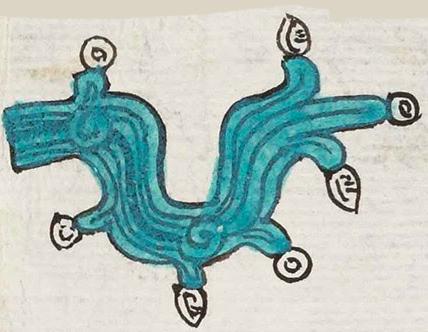Acocolco (Mdz28r)
This compound glyph, standing for the town name Acocolco, is primarily represented by water, (atl), painted turquoise blue, and showing the usual current lines (some are thicker black lines), waves, and splashes with turbinate shells and droplets (or, perhaps another type of shell or a precious stone beads, such as the chalchihuitl). The flow of the water has a notable bend in it, which may be a nod to the word for shoulder, acolli. The lines of current in this representation of water include two swirls or whirlpools. Swirling water also appears in the examples from folio 24 verso (very similar to this one) and, in a more exaggerated way on folio 12 recto.
Stephanie Wood
Frances Karttunen points to the root cohcōlli (something bent randomly). She reminds us reminds us that the reduplicated form with saltillo (glottal stop) is the "distributive" form. It indicates randomness, non-orderliness.
As Gordon Whittaker points out, "acol" is a pseudo-logogram that really intends "ā" (water) and "col" (for something bent), intending to refer to a location such as curve on the lakeshore. [See his book, Deciphering Aztec Hieroglyphs, 2021, 180.] Whittaker also suggests that Acocolco is a variant of Acolco. The reduplication of the "co" led Berdan and Anawalt to suggest that the verb cocoloa (in turn a reduplication of the verb coloa), to go somewhere by twists and turns, may have been intended to speak to the flow of the river. Reduplication in Nahuatl can apply to both nouns and verbs.
Stephanie Wood
acocolco. puo
Acocolco, pueblo
Stephanie Wood
c. 1541, or by 1553 at the latest
Stephanie Wood
river bend, rivers, bends, curves, twists, turns, water, shells, ríos, giros, torceduras, curvas, caracoles, agua, nombres de lugares

a(tl), water, https://nahuatl.wired-humanities.org/content/atl
acol(li), shoulder, https://nahuatl.wired-humanities.org/content/acolli
coltic, curved, bent, https://nahuatl.wired-humanities.org/content/coltic
coloa, to twist or turn, https://nahuatl.wired-humanities.org/content/coloa
cocoloa, to go by twists and turns, https://nahuatl.wired-humanities.org/content/cocoloa
-co (locative suffix), on, https://nahuatl.wired-humanities.org/content/co
"On the Twisting River" (suggested by Berdan and Anawalt, and supported by Frances Karttunen. [Frances Karttunen, unpublished manuscript, used here with her permission.]
"On the Twisting River" (Berdan and Anawalt, 1992, vol. 1, p. 169)
"Junto al Río Sinuoso," or "Junto al Río Que Se Dobla"
Stephanie Wood
Codex Mendoza, folio 28 recto, https://digital.bodleian.ox.ac.uk/objects/2fea788e-2aa2-4f08-b6d9-648c00..., image 66 of 188.
The Bodleian Libraries, University of Oxford, hold the original manuscript, the MS. Arch. Selden. A. 1. This image is published here under the UK Creative Commons, “Attribution-NonCommercial-ShareAlike 3.0 License” (CC-BY-NC-SA 3.0).




